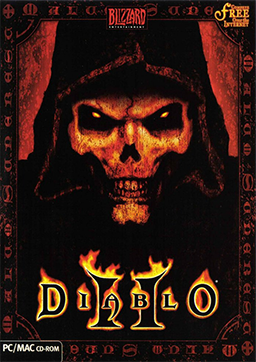
Diablo II is an action role-playing hack-and-slash video game developed by Blizzard North and published by Blizzard Entertainment in 2000 for Microsoft Windows, Classic Mac OS, and OS X. The game, with its dark fantasy and horror themes, was conceptualized and designed by David Brevik and Erich Schaefer, who, with Max Schaefer, acted as project leads on the game. The producers were Matthew Householder and Bill Roper. The game was developed over a three-year period, with a crunch time of a year and a half.
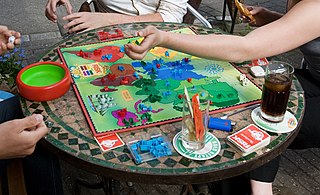
Risk is a strategy board game of diplomacy, conflict and conquest for two to six players. The standard version is played on a board depicting a political map of the world, divided into 42 territories, which are grouped into six continents. Turns rotate among players who control armies of playing pieces with which they attempt to capture territories from other players, with results determined by dice rolls. Players may form and dissolve alliances during the course of the game. The goal of the game is to occupy every territory on the board and, in doing so, eliminate the other players. The game can be lengthy, requiring several hours to multiple days to finish. European versions are structured so that each player has a limited "secret mission" objective that shortens the game.

Axis & Allies is a series of World War II strategy board games. The first version was initially published in 1981 and a second edition known colloquially as Axis & Allies: Classic was published in 1984. Played on a board depicting a Spring 1942 political map of Earth divided by territories, players take the role of one or more of the five major belligerents of World War II: the Axis powers of Germany and Japan; and the Allied powers of the Soviet Union, the United Kingdom, and the United States. Turns rotate among these belligerents, who control armies of playing pieces with which they attempt to capture enemy territories, with results determined by dice rolls. The object of the game is to win the war by capturing enough critical territories to gain the advantage over the enemy.

Master of Orion is a turn-based, 4X science fiction strategy game in which the player leads one of ten races to dominate the galaxy through a combination of diplomacy and conquest while developing technology, exploring and colonizing star systems.

Battlefield 1942 is a 2002 first-person shooter video game developed by Digital Illusions CE and published by Electronic Arts for Microsoft Windows and Mac OS X. The game can be played in single-player mode against the video game AI or in multiplayer mode against players on the Internet or in a local area network. It is a popular platform for mod developers, with many released modifications that alter the gameplay and theme.

Panzer General is a 1994 computer wargame developed and published by Strategic Simulations Inc. (SSI). It simulates conflict during World War II. The designers of Panzer General were heavily influenced by the Japanese wargame series Daisenryaku.
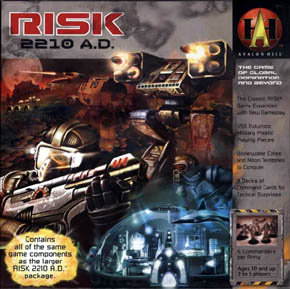
Risk 2210 A.D. is a 2–5 player board game by Avalon Hill that is a futuristic variant of the classic board game Risk. Risk 2210 A.D. was designed by Rob Daviau and Craig Van Ness and first released in 2001. In 2002, it won the Origins Award for "Best Science Fiction or Fantasy Board Game of 2001".

Medieval: Total War is a turn-based strategy and real-time tactics computer game developed by Creative Assembly and published by Activision. Set in the Middle Ages, it is the second game in the Total War series, following on from the 2000 title Shogun: Total War. Originally announced in August 2001, the game was released in North America on 19 August 2002 and in Europe on 30 August for Microsoft Windows.
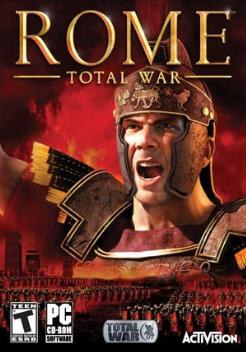
Rome: Total War is a strategy video game developed by The Creative Assembly and originally published by Activision; its publishing rights have since passed to Sega. The game was released for Microsoft Windows in 2004. The macOS version was released on February 5, 2010, by Feral Interactive, who also released the iPad version on November 10, 2016, the iPhone version on August 23, 2018, and the Android version on December 19, 2018. The game is the third title in The Creative Assembly's Total War series, following Shogun: Total War, and Medieval: Total War.

Victoria: An Empire Under the Sun is a grand strategy videogame by Paradox Entertainment, released in 2003. It covers primarily its namesake the Victorian period (1837–1901) and beyond, specifically 1836–1920 for the main game, and extends until 1936 if the expansion is installed. The game runs on a modified version of the Europa Engine, and the lead game programmer was Johan Andersson. It was later ported to Macintosh by Virtual Programming.
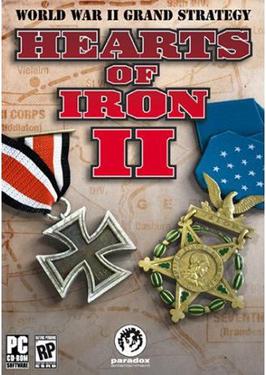
Hearts of Iron II is a grand strategy computer war game for Microsoft Windows based upon its predecessor, Hearts of Iron, which was developed by Paradox Development Studio and published by Paradox Interactive.

Command & Conquer: Red Alert 2 is a real-time strategy video game which was released for Microsoft Windows on October 24, 2000 as the follow-up to Command & Conquer: Red Alert. Red Alert 2 picks up at the conclusion of the Allied campaign of the first game. Its expansion pack is Command & Conquer: Yuri's Revenge, released a year later in 2001. Red Alert 2 was principally developed by Westwood Pacific in collaboration with Westwood Studios.

Master of Orion II: Battle at Antares is a 4X turn-based strategy game set in space, designed by Steve Barcia and Ken Burd, and developed by Simtex, who developed its predecessor Master of Orion and Master of Magic. The PC version was published by MicroProse in 1996, and the Macintosh version a year later by MacSoft, in partnership with MicroProse. The game has retained a large fan base, and is still played online.
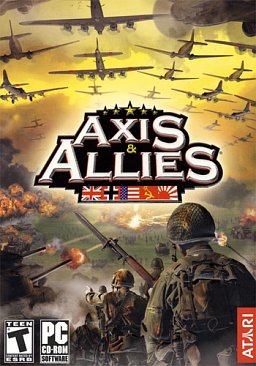
Axis & Allies is a real-time strategy World War II video game developed by TimeGate Studios and published by Atari for Microsoft Windows. The game was released on November 2, 2004. It is based on the board game series Axis & Allies from Milton Bradley and also on TimeGate's Kohan series. Set in the years after Japan and the United States entered into the war, the game allows the player to act as a World War II commander to build military forces to fight against other generals, using military units and technologies from the war. The player is able to rewrite and recreate the history of World War II.

North & South is a strategy action game released in 1989 for the Amiga, and Atari ST and ported to the Nintendo Entertainment System, Amstrad CPC, MSX, MS-DOS, Commodore 64 and ZX Spectrum. It was developed and published by Infogrames.

The Lord of the Rings: The Battle for Middle-earth II is a 2006 real-time strategy video game developed and published by Electronic Arts. The second part of the Middle-earth strategy game series, it is based on the fantasy novels The Lord of the Rings and The Hobbit by J. R. R. Tolkien and its live-action film series adaptation. It is the sequel to Electronic Arts' 2004 title The Lord of the Rings: The Battle for Middle-earth. Along with the standard edition, a Collector's Edition of the game was released, containing bonus material and a documentary about the game's development.
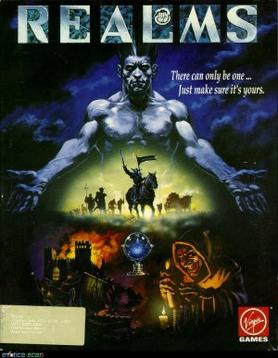
Realms is a 1991 real-time strategy game produced by Graftgold Ltd. for MS-DOS, Amiga, and Atari ST. It was published by Virgin Games. In Realms, the player has to build cities, collect taxes, create troops and fight enemy cities and troops in order to defeat their opponents.

BattleTech: The Crescent Hawks' Revenge is a real-time tactics game based in the FASA BattleTech universe. It is a direct sequel to BattleTech: The Crescent Hawk's Inception, though the gameplay is considerably different from that of the first title, which was primarily an adventure/role-playing game. Developed by Westwood Associates for Mediagenic, and produced by Scott Berfield, the game serves as a prototype for what later became Dune II, the first real-time strategy title on the PC.

Warhammer 40,000: Dawn of War – Dark Crusade is the second expansion to the real-time strategy video game Warhammer 40,000: Dawn of War developed by Relic Entertainment and published by THQ. Based on Games Workshop's tabletop wargame, Warhammer 40,000, Dark Crusade was released on October 9, 2006. The expansion features two new races, the Tau Empire and the Necrons. Including the Imperial Guard from Dawn of War's first expansion pack Winter Assault, a total of seven playable races in this expansion.



















